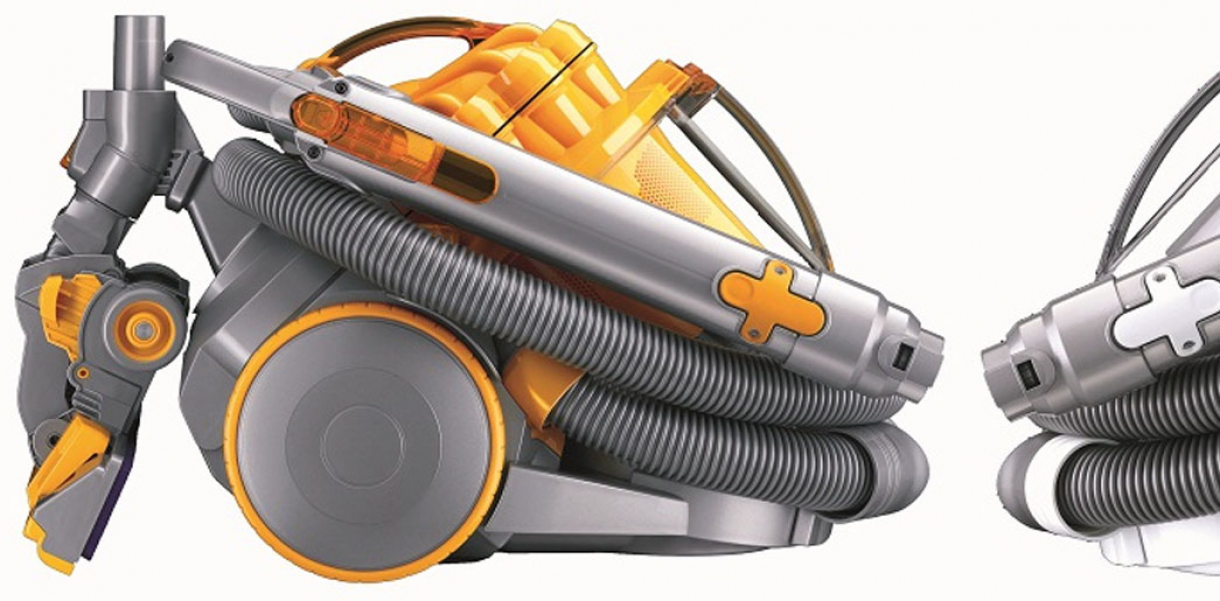Today Dyson's breakthrough vacuum cleaner commands over 50% market share in the UK, has become the model for appliance innovation worldwide and has spawned legions of imitations from the same entrenched industry players who earlier declined to license his fledgling invention.
Functionality and use of design
The Dyson Dual Cyclone machine is so-named because an outer cyclone, rotating at 200 mph, removes large debris and most dust, while an inner cyclone, rotating at 924 mph, creates an intense gravitational force to drive the finest dust, including particles of cigarette smoke, out of the air. The design uses a bagless cyclonic suction system, which employs an array of seven conical cylinders that allow it to achieve a blistering 100K G’s of centrifugal force. This technology allows the vacuum to maintain a continuous suction unrivaled by any other bag or bagless manufacturer.
How did this design improve life?
For the better part of the 20th century, the vacuum cleaner industry has used the same principle for collecting dust introduced in 1901. Only the physical look was ``repackaged." It took industrial designer James Dyson to revolutionize the technology and insist that the function drive the design.
James Dyson studied industrial design at England's Royal College of Art and ended up selling vacuum cleaners. Figuring he could improve on vacuum cleaners, Dyson went through 5000 prototypes during 25 years of rejection by established manufacturers and venture capitalists before manufacturing and marketing his revolutionary Dyson’s Dual Cyclone “bagless” vacuum cleaner on his own. The owner never has to buy bags or filters and the cleaner is the only one that never loses suction. The Dyson’s look is so futuristic and fun that users love to bring it out of the closet (I know because we have one). That radical appearance is the outward signifier of a functional design that has revolutionized an industry.
Today Dyson's breakthrough “bagless" vacuum cleaner commands a 50% market share in the UK and is the top selling vacuum cleaner in the U.S. Dyson has become a worldwide icon for appliance innovation. Since its launch in 1993, Dyson Appliances Ltd., located in Malmesbury, England, has spawned legions of imitations from the same entrenched industry players who earlier declined to license his fledgling invention. The Dyson comes in a range of upright and canister models.
Dyson's foray into developing vacuum cleaner technology happened by chance. In 1978, while renovating his 300-year-old farmhouse, Dyson became frustrated with the poor performance of his conventional vacuum. ``Whenever I went to use it, there was no suck in it. One day I thought I would find out what was wrong with the design," he relates. He noted that the appliance worked by drawing air through the bag to create suction, but when even a fine layer of dust got inside, it clogged its pores, stopping the airflow and suction. He tried other brands and found they all had the same problem. ``Here was a product that people used every day and it had a real Achilles heel," he says.
In his usual style of seeking solutions from unexpected sources, Dyson thought of how a nearby sawmill used a cyclone–a 30-foot-high cone that spun dust out of the air by centrifugal force–to expel waste. He reasoned that a vacuum cleaner that could separate dust by cyclonic action and spin it out of the airstream would eliminate the need for both bag and filter. Dyson set out to replicate the cyclonic system.
Five years and more than 5,000 prototypes later, he arrived at the Dual Cyclone machine–so-named because an outer cyclone, rotating at 200 mph, removes large debris and most dust, while an inner cyclone, rotating at 924 mph, creates an intense gravitational force to drive the finest dust, including particles of cigarette smoke, out of the air.
While Dyson opted to make the cyclonic system brightly colored, he insisted on keeping the dust bin itself clear, even though consumer focus groups and retailers responded in horror to the idea. Explaining why he ignored them, Dyson says, ``You can use focus groups to find out what they think about what's on the market at the moment but it really doesn't help you make a revolution because a revolution is, by its nature, counter culture. It goes against what people are currently choosing. It's difficult to ask consumers what they think of a totally new concept because they don't really know anything about it. They haven't gotten used to it; they're not familiar with it." To Dyson, a see-through bin provided the benefit of knowing when the bin was full and seeing the cyclones in action. ``You see what you're doing; there's a kind of delight in it." The consumer agreed. The clear bin has become a signature of Dyson's design.
Not one to accept the status quo, Dyson is continually trying to achieve cutting-edge improvements in household appliances that have changed little over the decades. In addition to a revolutionary new washing machine, his company is working on a robotic vacuum cleaner, equipped with sensory devices, that can navigate its way around a room, knowing which way to go, where it has cleaned and when it is finished.
``We're not interested in just creating another designer product," Dyson stresses. ``We're interested in doing something where we come up with breakthrough technology which makes a radical improvement in the product. It's all about performance. We stick to things where there is fantastic improvement." Dyson is confident that his robotic cleaner, currently in home trials, will eventually succeed. He predicts, ``I think in 5-10 years’ time, we'll consider it fairly unusual if we're actually pushing a vacuum around the home."
Dyson is extremely active in charitable and educational philanthropy. In an effort to encourage young people to see design and technology as a creative, exciting subject, Dyson has developed resources for students and teachers of design and technology. Dyson has an education box that includes a Dyson vacuum cleaner for product analysis, modified floor tools for disassembly and an interactive CD-Rom. Information packs for teachers and students are also available to download from the Dyson web site, www.dyson.co.uk/education/resources
Dyson also has teamed up with the Industrial Designers Society of America to sponsor an “Eye For Why Design & Engineering Competition” to challenge industrial design students to create an innovative household product that reflects Dyson’s philosophy and commitment to intelligent, function-first design and will be designed to work better by solving a problem.
Drawbacks of life improvement
There have been protests about Dyson moving much of its manufacturing to Malaysia and about the low wages paid to Malaysian workers
Research and need
Over a period of 25 years, Dyson made 5,000 prototypes. Research and Development, both functional and user research, is a cornerstone of Dyson’s development center in Malmsebury, England.
While Dyson opted to make the cyclonic system brightly colored, he insisted on keeping the dust bin itself clear, even though consumer focus groups and retailers responded in horror to the idea. Explaining why he ignored them, Dyson says, ``You can use focus groups to find out what they think about what's on the market at the moment but it really doesn't help you make a revolution because a revolution is, by its nature, counter culture. It goes against what people are currently choosing. It's difficult to ask consumers what they think of a totally new concept because they don't really know anything about it. They haven't gotten used to it; they're not familiar with it." To Dyson, a see-through bin provided the benefit of knowing when the bin was full and seeing the cyclones in action. ``You see what you're doing; there's a kind of delight in it." The consumer agreed. The clear bin has become a signature of Dyson's design.
Dyson continues to push the R&D envelope. New developments include a “smart” vacuum cleaner that can order its own spare parts when it has broken down. The machine, which will be on sale in the UK soon, lets the owner know when it needs replacement parts and then transmits a message to engineers giving details on what is wrong and what new part it needs.
In addition to a revolutionary new washing machine, his company is working on a robotic vacuum cleaner, equipped with sensory devices, that can navigate its way around a room, knowing which way to go, where it has cleaned and when it is finished.
In 2004, Dyson launched the revolutionary Dyson Digital Motor.
``We're not interested in just creating another designer product," Dyson stresses. ``We're interested in doing something where we come up with breakthrough technology which makes a radical improvement in the product. It's all about performance. We stick to things where there is fantastic improvement." Dyson is confident that his robotic cleaner, currently in home trials, will eventually succeed. He predicts, ``I think in 5-10 years’ time, we'll consider it fairly unusual if we're actually pushing a vacuum around the home."
And James Dyson announced he would be investing £50 million on research and development in 2005, £10 million more than in 2004.
Designed by James Dyson - United Kingdom




